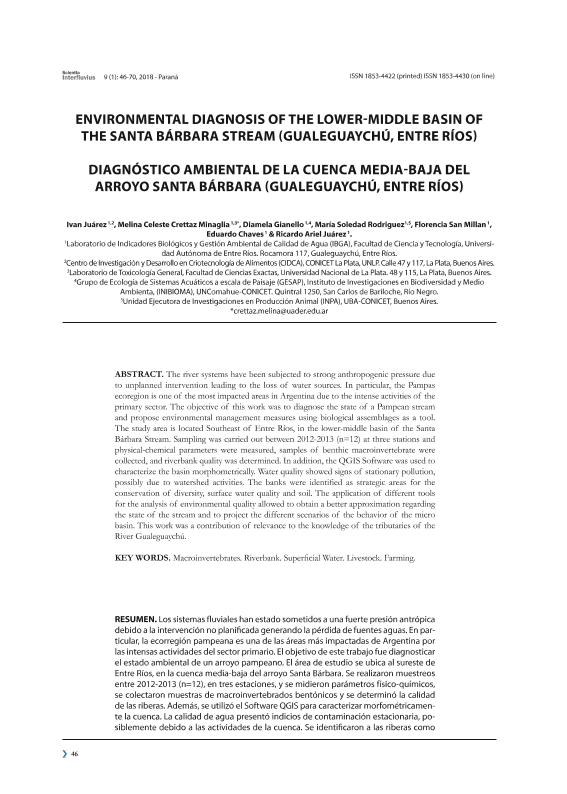Artículo
Los sistemas fluviales han estado sometidos a una fuerte presión antrópica debido a la intervención no planificada generando la pérdida de fuentes aguas. En particular, la ecorregión pampeana es una de las áreas más impactadas de Argentina por las intensas actividades del sector primario. El objetivo de este trabajo fue diagnosticar el estado ambiental de un arroyo pampeano. El área de estudio se ubica al sureste de Entre Ríos, en la cuenca media-baja del arroyo Santa Bárbara. Se realizaron muestreos entre 2012-2013 (n=12), en tres estaciones, y se midieron parámetros físico-químicos, se colectaron muestras de macroinvertebrados bentónicos y se determinó la calidad de las riberas. Además, se utilizó el Software QGIS para caracterizar morfométricamente la cuenca. La calidad de agua presentó indicios de contaminación estacionaria, posiblemente debido a las actividades de la cuenca. Se identificaron a las riberas como zonas estratégicas para la conservación de la diversidad, calidad del agua superficial y del suelo. La aplicación de distintas herramientas para el análisis de calidad ambiental permitió obtener una mejor aproximación respecto al estado del arroyo y proyectar los distintos escenarios del comportamiento de la microcuenca. Este trabajo significó un aporte de relevancia al conocimiento de los tributarios del río Gualeguaychú. The river systems have been subjected to strong anthropogenic pressure due to unplanned intervention leading to the loss of water sources. In particular, the Pampas ecoregion is one of the most impacted areas in Argentina due to the intense activities of the primary sector. The objective of this work was to diagnose the state of a Pampean stream and propose environmental management measures using biological assemblages as a tool. The study area is located Southeast of Entre Ríos, in the lower-middle basin of the Santa Bárbara Stream. Sampling was carried out between 2012-2013 (n=12) at three stations and physical-chemical parameters were measured, samples of benthic macroinvertebrate were collected, and riverbank quality was determined. In addition, the QGIS Software was used to characterize the basin morphometrically. Water quality showed signs of stationary pollution, possibly due to watershed activities. The banks were identified as strategic areas for the conservation of diversity, surface water quality and soil. The application of different tools for the analysis of environmental quality allowed to obtain a better approximation regarding the state of the stream and to project the different scenarios of the behavior of the micro basin. This work was a contribution of relevance to the knowledge of the tributaries of the River Gualeguaychú.
The lower-middle basin of the Santa Bárbara stream (Gualeguaychú, Entre Ríos)
Título:
Diagnóstico ambiental de la cuenca media-baja del arroyo Santa Bárbara (Gualeguaychú, Entre Ríos)
Juárez, Ivan ; Crettaz Minaglia, Melina Celeste
; Crettaz Minaglia, Melina Celeste ; Gianello, Diamela; Rodríguez, María Soledad; San Millán, Florencia; Chaves, Eduardo; Juárez, Ricardo Ariel
; Gianello, Diamela; Rodríguez, María Soledad; San Millán, Florencia; Chaves, Eduardo; Juárez, Ricardo Ariel
 ; Crettaz Minaglia, Melina Celeste
; Crettaz Minaglia, Melina Celeste ; Gianello, Diamela; Rodríguez, María Soledad; San Millán, Florencia; Chaves, Eduardo; Juárez, Ricardo Ariel
; Gianello, Diamela; Rodríguez, María Soledad; San Millán, Florencia; Chaves, Eduardo; Juárez, Ricardo Ariel
Fecha de publicación:
06/2018
Editorial:
Universidad Autónoma de Entre Ríos
Revista:
Scientia Interfluvius
ISSN:
1853-4422
e-ISSN:
1853-4430
Idioma:
Español
Tipo de recurso:
Artículo publicado
Clasificación temática:
Resumen
Palabras clave:
Macroinvertebrados
,
Ribera
,
Agua superficial
,
Ganadería
,
Agricultura
Archivos asociados
Licencia
Identificadores
Colecciones
Articulos(CIDCA)
Articulos de CENTRO DE INV EN CRIOTECNOLOGIA DE ALIMENTOS (I)
Articulos de CENTRO DE INV EN CRIOTECNOLOGIA DE ALIMENTOS (I)
Articulos(INIBIOMA)
Articulos de INST. DE INVEST.EN BIODIVERSIDAD Y MEDIOAMBIENTE
Articulos de INST. DE INVEST.EN BIODIVERSIDAD Y MEDIOAMBIENTE
Citación
Juárez, Ivan; Crettaz Minaglia, Melina Celeste; Gianello, Diamela; Rodríguez, María Soledad; San Millán, Florencia; et al.; The lower-middle basin of the Santa Bárbara stream (Gualeguaychú, Entre Ríos); Universidad Autónoma de Entre Ríos; Scientia Interfluvius; 9; 1; 6-2018; 46-70
Compartir



